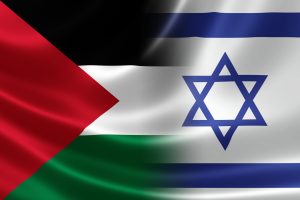In response to a terrorist attack by Hamas on October 7, Israel has imposed a siege on Gaza and launched thousands of airstrikes that have left around 8,000 people dead in three weeks. With the exception of Turkmenistan, Central Asian governments quickly issued statements condemning the violence and calling for a swift resolution of the conflict.
How salient has the war been for average people in Central Asia? How is the Israel-Hamas war being covered by local news outlets and discussed on social media?
The most grassroots action has taken place in Kyrgyzstan, where about 100 people gathered in Bishkek for a rally in support of Palestine on October 21. Attendees carried signs with the Palestinian flag and messages like “Stop war,” “Stop terrorism,” and “Free Palestine” written in English. Another rally was organized the next weekend, and the event on October 28 drew an estimated crowd of 700-1,000 people.
Organizers of the October 28 rally are related to Kyrgyz politician Tursunbai Bakir uulu, who made headlines in August 2014 when he ripped up an Israeli flag in protest of Israel military operations in Gaza that summer. Bakir uulu recently appeared on a podcast hosted by Nurseyit Anarkulov to discuss the history of the conflict.
In the interview, which was posted on October 22, Bakir uulu draws on many conspiratorial tropes to talk about the founding of the Israeli state and the stakes of the information war. “I’m not an anti-Semite, I’m just stating historical facts,” Bakir uulu claimed. “In all these European international scandals and wars, Jews are involved.”
Bakir uulu drew some interesting parallels between what’s happening in Palestine, how the media covered recent violence between Kyrgyzstan and Tajikistan, and an episode in 1999 when militants from the Islamic Movement of Uzbekistan took several hostages in Batken, a region in southern Kyrgyzstan. He spoke to the importance of providing Palestinians with charitable assistance and mentioned the October 28 rally.
The YouTube video of the podcast has been viewed 109,000 times in nine days, with some 1,500 comments laden with Palestinian flag emojis and messages of peace from citizens of Kyrgyzstan, Kazakhstan, and Tajikistan. The public comments do not echo Bakir uulu’s controversial commentary on Israel or Jews, instead focusing on supporting Palestinians. The podcast has gotten a lot of attention on other social media platforms as well, with a short clip circulating on TikTok getting 540,000 views and 21,000 likes on Instagram.
It’s difficult to deduce the nature of public opinion on Israel-Palestine just from view counts and emojis, though.
Efforts are underway in Kyrgyzstan to examine how people are thinking about the war in a more systematic way. Kaktus reported that a research center affiliated with Bishkek Humanitarian University conducted a nationwide survey of attitudes about Israel’s war with Hamas. Forty-eight percent of the 818 respondents reported that they “completely support Palestine,” compared to only 1.2 percent of respondents who expressed that level of support for Israel. Almost 9 percent said they support Palestine, but they condemn terrorist attacks. Some 21 percent of respondents found it hard to answer the question or said they did not know enough to express an opinion.
In Kazakhstan, the only instance of protest that has shown up in local media is a single-person picket on October 19. A young woman wearing a Palestinian flag and keffiyeh scarf cut up her Starbucks Gold Card in protest of the company’s move to sue its labor union over a message of support for Palestinians.
In Tashkent, there had been plans for a peaceful demonstration in support of Palestinians on October 29. Gazeta.uz reported that the demonstration was advertised on social media with captions “Shoulder to shoulder with Palestine” and “15 days don’t scare me,” the latter a reference to the punishment for those found guilty of holding an unsanctioned public event in the country. Gazeta.uz estimated that about 100 people showed up and were met by law enforcement agents who detained some attendees for questioning.
Uzbek-language media platforms have been covering events in Palestine closely. Kun.uz, the most-visited website in Uzbekistan, has been publishing videos that explain the dynamics of the Israel-Hamas war and discuss the conflict’s geopolitical and economic implications. These videos have racked up hundreds of thousands of views in just four or five days.
Islamic social media accounts have also been posting actively. For example, an Uzbek-language YouTube channel called MADINA STUDIO TV posted four videos about Palestine in the last two weeks that have been viewed a total of 2.8 million times.
The progressive-leaning accounts from Kazakhstan and Kyrgyzstan that have previously gone viral with memes and carousel-style visuals that explain controversial political issues have not been churning out much content. While researchers have warned about the dangers of social media as a tool for extremist organizing, it is important not to overlook the ways that Muslim civil society uses the internet to disseminate religious values. This understudied corner of the internet stands to help make sense of how Central Asians view the war in Gaza.

































